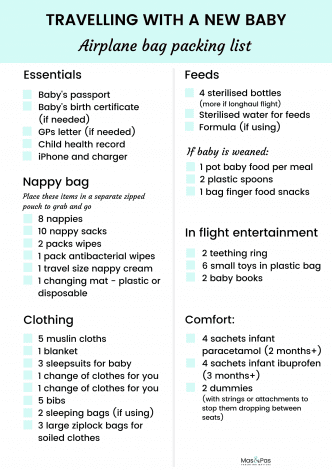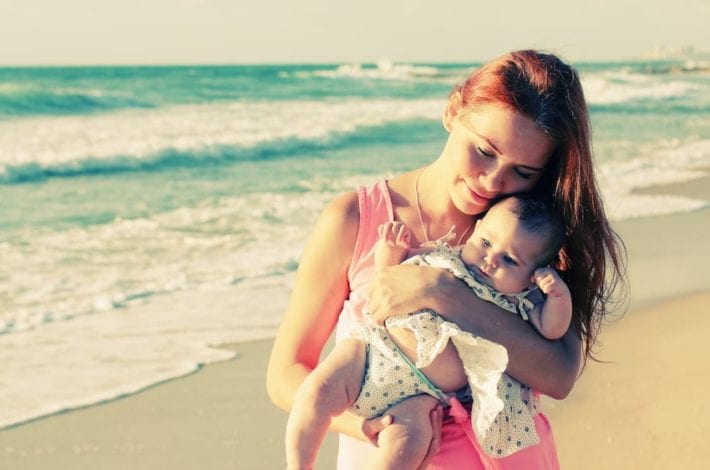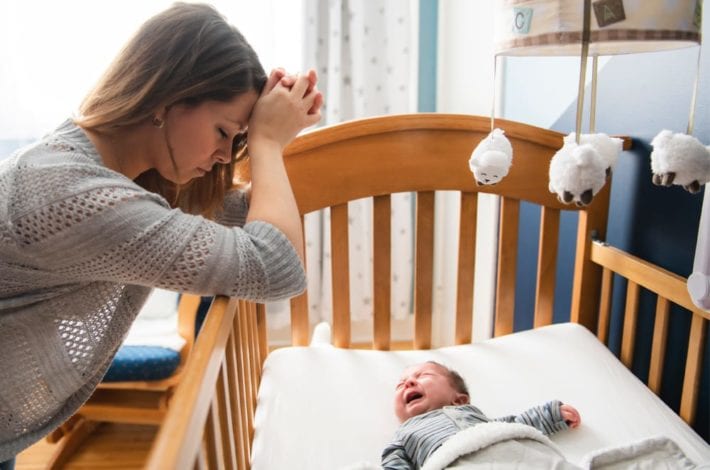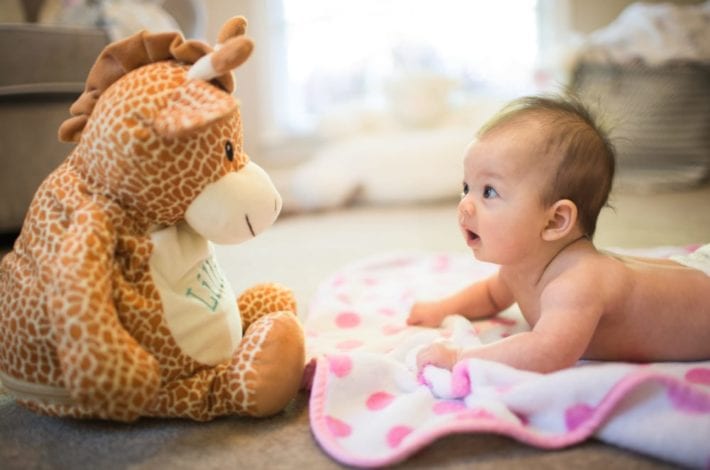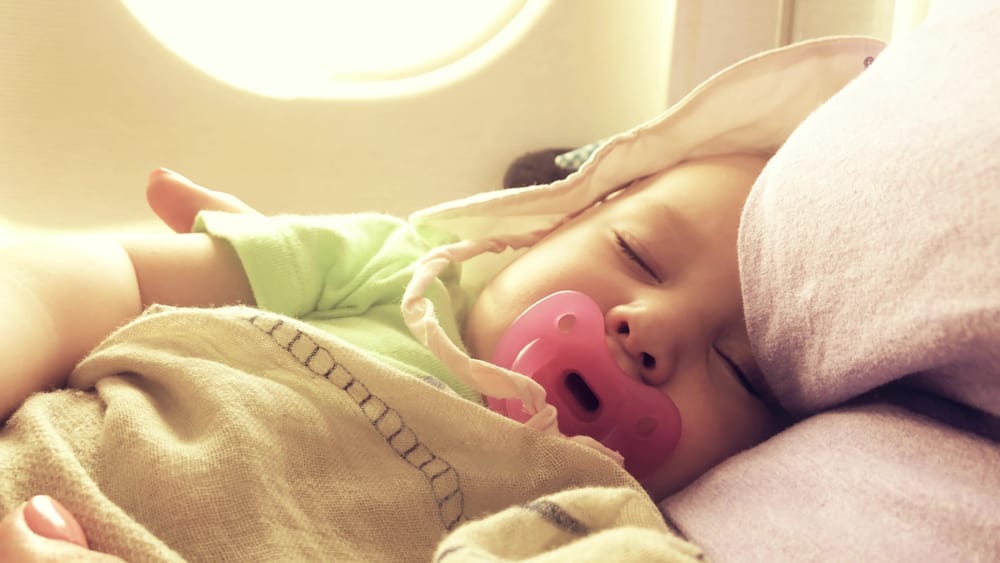

How old does my baby have to be to fly?
How do you travel on a plane with a newborn?
Is it safe to travel with a newborn? What do I pack?
The first time we travel with baby we can have these and many other questions reeling around in our heads.
Here we break down what you need to know flying with a newborn, including air plane regulations, tips to make your flight go more smoothly. We’ve also put together some FREE downloadable pdfs:
- PACKING CHECKLIST FOR BABY’S AIRPLANE BAG. A packing list of the essentials you will need for your hand luggage when travelling with a baby.
- PACKING CHECKLIST FOR BABY’S SUITCASE. A packing list of the items you will need for your baby’s suitcase when going on holiday.
Check your airline’s age limit for newborn babies
Many airlines allow a newborn baby to travel from as early as 2 weeks old. A few allow newborns to fly from as early as 2-7 days old. Others have stricter rules, only accepting babies over 2 months of age.
It’s worth noting that if your baby was born early then you may have to count his age from his due date as opposed to from his birth date.
It’s always best to check with your airline first, so that you’re clear about how old your baby has to be to fly and what documentation they require in advance.
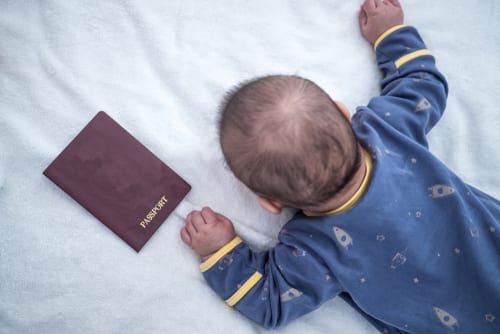

Prepare the documents you will need
Check with your airline as to what exactly they need, but documentation airlines require may include:
- Birth certificate – some airlines may require you to provide the birth certificate to prove the age of your baby.
- Letter from GP – some airlines require a letter from your GP giving both you and your baby the all-clear to fly. If you have had a c-section then you may not be able to fly until after your 6 week postnatal check when your GP signs you off.
- Passport for baby – Your baby will need a passport to fly, so allow enough time to send off and receive this before you travel.
How to take a passport photograph of baby
Passport photograph rules are less strict for little babies as they don’t have to look directly at the camera or have a neutral expression, or even have their eyes open.
A great tip is to lie your baby on the floor on a white blanket or sheet and take the photo from overhead. Do not include a hat, dummy or anything else that covers your baby’s face in the photo.
Make sure that there are no shadows and that your photographs are in colour. You can find a full guide of requirements for UK passport photographs here.
Check it’s safe to fly with your newborn
Air travel is considered appropriate for most newborn babies. There are a number of considerations worth taking into account though, including:
- Your baby’s age from their due date. Due to their developing immune systems, some doctors are concerned about newborn babies flying due to the risk of their catching infectious diseases. Some recommend that you wait for 1 month before travelling unless it cannot be avoided, while others prefer that you wait until baby is 3-6 months old. Consult your doctor for their own advice. If your baby is old enough to have their routine vaccines at 8 weeks then it’s definitely worth getting those vaccinations done before travelling.
- Your baby’s breathing. As the air pressure in the cabin is lower than it would be on the ground, the oxygen levels are also lower. For that reason if your baby has had any heart or lung problems, or any respiratory infections or symptoms, it’s best to speak to your doctor about them before flying. Otherwise healthy babies don’t seem to be affected by flights.
- Your baby’s ears. Babies may struggle to equalise during take off and landing. Breastfeeding them or offering a dummy or bottle can help them to adjust to the changes in pressure. However, if they have had any ear infections or ear surgery before flying, then speak to your GP.
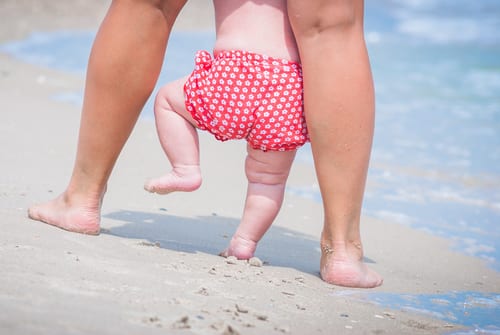

Research your holiday destination
It’s always worth checking to see if there are any outbreaks of infections in the country you are flying to e.g. measles, mumps and rubella, in case your baby is too young or hasn’t been vaccinated.
You can check on the Traveller’s Health section of the Centres of Disease Control’s website. This site is full of useful information about countries to avoid with a baby or children because of infectious disease outbreaks or natural disasters.
If you’re worried, discuss your travel destination with your GP before you book.
It’s also advisable to avoid holiday destinations that are too hot or too cold as newborn babies struggle to regulate their temperature and also need to be kept out of the sun.
Decide how you want to travel on the plane with your newborn
There are two main ways you can travel with your newborn baby:
In their own airplane seat, secured in a car seat.
When you travel with baby you can choose to pay for an airplane seat for them which is charged either at full adult fare or at a child fare, depending on the airline.
If you book a seat for your baby, then you should bring a car seat for them to sit in. It must be government-approved, with labels stating that it is approved for vehicles and aircraft travel.
We also recommend checking with your chosen airline that they allow car seats in the cabin. And if so which car seats they allow and where on the plane they allow car seats to be placed on.
Look into all this before purchasing a ticket for baby and reserving your seat on the aircraft.
The Federal Aviation Administration recommends that the safest way to travel on an airplane is by having a baby secured in a government approved car seat on their own airplane seat.
However it’s also worth mentioning that car seats can be heavy and if you bring them on board a flight, you will be carrying them to and from the terminal. Unless you are also travelling with a pram wheel base that the car seat can clip onto until just before you board and as soon as you disembark, unfortunately bringing a car seat on board often means you will be lugging it around long stretches of airport space, together with baby and bags.
So while it is the safest and most recommended form of travel for baby, the convenience is also something to keep in mind.
Holding your baby on your lap.
Most airlines give you the option of carrying your baby on your lap, in which case you share an airplane seat. Some domestic flights offer this for free, others charge a smaller fee for baby.
As a guide this can be about 10% of an adult fare, though it varies from airline to airline.
If your baby is on your lap, then the cabin crew will give you a seat belt for baby that fastens onto yours for take-off and landing. If you’re unsure how to secure them, then always ask for help.
What about baby bassinets?
On longhaul flights some airlines offer the option of a baby bassinet on board.
Airplane bassinets are small detachable cribs which are fixed to the wall of the plane in front of your seat. They are offered to those in the bulkhead seats only, so the supply is limited and they usually require booking in advance.
Some airlines allocate them on a first-come first-served basis in which case it’s a good idea to check in early, for the best chance of getting one.
Baby bassinets can be a godsend for families with little ones. They provide somewhere to place their babies to sleep instead of having to hold them in their laps or keep them in car seats.
For older babies some airlines offer a reclining car seat where baby can be strapped in.
Check what your airline’s bassinets look like and until what age they provide them, to see if they are right for you.
To help you make up your mind we’ve done a little recap of the options:
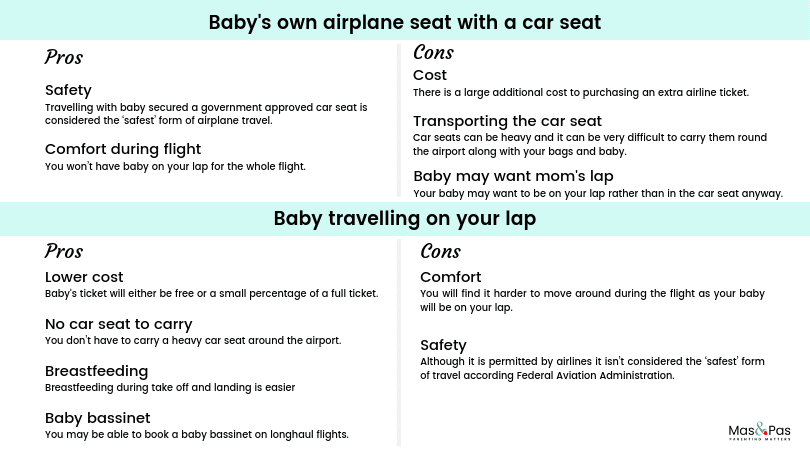



Reserve the right seats on the aircraft
Book your preferred seats well in advance for the most comfortable flight.
Bulkhead seats are ideal
Bulkhead seats (seats which have the divider in front of them rather than other seats) are the most convenient seats to have when flying with a baby, or even a toddler. This is because they tend to have the most leg room.
This extra space can allow you to stand up and hold your baby more easily if you need to mid-flight. For long-haul flights you also have the best chance of being allocated a baby bassinet if you’re sitting in the bulkhead seats.
You often need to pre-book baby bassinets well in advance so don’t presume you’ll get one automatically.
Reserve seats at the front of the plane
If bulkhead seats are not available then the seats at the front of the plane have less turbulence and noise than those at the back.
It can be worth reserving your places in the first few rows if you can.
2 to 3 seat trick
One way to give yourself the best chance of getting more space on a flight, is to book yourself on the aisle seat and your partner on the window seat of a particular row, leaving the middle seat between you open.
When you check-in, you can ask for the middle seat to be blocked off if the flight is not full, as you will have your baby with you on your lap. There’s a chance that they will be able to do this and you will have the 3 seats.
If you find that the flight is fully booked and that someone has been assigned the middle seat, you can always offer the window seat to the person in the middle. The other passenger is unlikely to complain at being moved out of the middle seat and in the meantime you’ve given yourselves the best chance of getting an extra seat between you for free.
If the flight is not full, the middle seats are the most likely to be left vacant, and you could end up with a free seat between you by chance. The additional space that this gives you, can make a huge difference to your comfort on a flight when you’re travelling with baby.
Pack your airplane bag for baby well
Packing the right airplane bag for baby can make your flight a lot less stressful.
Have plenty of extra nappies, wipes and formula if you’re bottle feeding in your hand luggage in case of delays. It’s also worth having a little zip lock bag with a few toys in too to keep your baby entertained while you wait to board your plane.
We’ve put together a FREE downloadable Packing list for baby’s airplane bag to help you keep your hand luggage to a minimum while also having the essentials that baby might need. You can edit it according to your flight time with the quantities you need.
It’s also helpful to remember that:
The 100 ml rule does NOT apply to baby’s milk
There are strict rules on airlines about only taking 100 ml of fluids in your hand luggage. However, these rules do NOT apply to breast milk or formula or baby food. Sterilised or boiled water is also permitted in quantities over 100 ml, if you need it to make up a formula feed for baby.
Gel or liquid filled teethers are also allowed on board.
The 100 ml rule does still apply to baby products like nappy cream, medicines and other lotions. So you will need to place these in a clear bag and make sure they don’t exceed 100 ml and that their containers are not for more than 100 ml either.
You might be asked to taste baby’s milk or food as you go through security so don’t be alarmed if you’re asked to do so.
Check what carry-on baggage allowance your airline allows with baby
If you pay for an extra seat for your baby, they get their own carry-on baggage allowance.
If you hold baby on your lap, many airlines still allow parents additional baggage allowance.
This includes changing bags, breast pumps, car seats and strollers. As it varies from airline to airline have a look at exactly what yours allows before packing.
Decide what to do with buggies and prams
Most airports and airlines allow you to keep your baby’s buggy up to the airplane door. At this point it will be taken and placed with the checked in baggage in the holds.
They usually aim to return the buggies to you at the airplane door after landing at your destination. However this often doesn’t happen and you may find that you have to wait until you reach the baggage reclaim to get your pram, together with the rest of the luggage.
As this delay can mean that you’re doing long walks through the airport carrying both bags and baby, and possibly a car seat too, many parents have opted to purchase travel buggies. These are strollers which are specifically designed to fold up small enough to fit in the overhead storage compartments of aircrafts. And they mean that you have your buggy with you the moment you land.
Choose travel products that will make your flight easier
Here are a few of our top travel products when flying with baby.
Classic sling
A sling is a godsend for parents travelling with small babies. You have bags and tickets and money to keep track of. You might also want to grab a meal or a coffee. Carrying your baby in a sling leaves you hands-free to do all these things.
If you have a sling, which doesn’t have metal straps or clasps then you may not even have to take it off to go through security.
A great soft sling is the Baby Wrap Ergo Carrier Sling by Cuddlebaby. It’s comfortable and also versatile as it can be used as a nursing cover and a post partum belt too.
If you prefer a more supportive baby carrier over a soft sling, then take a look at the BabyBjorn One Air Baby Carrier, which has thicker straps and more support for baby.
Travel buggy
Having a travel buggy which compacts and fits into the overhead compartment of a flight might become your favourite piece of travel kit. When you land you simply unfold it and pop baby in. You can also hang your hand luggage over it, which means you’re carrying less through the airport.
Check that your airline allows your particular brand of buggy on board. A well known and often accepted brand for air travel is the Babyzen Yoyo+ stroller which can be used from 0 months plus, when purchased together with it’s Newborn pack. We like it because it’s light but it’s also not too flimsy. It’s good enough to be used as an everyday pram if you live in a town or city centre and don’t need any large, off-road pram wheels.
You can look at purchasing these strollers second hand if you want to save on cost. Otherwise there are a number of other more economical brands to choose from, which also fold up very small.
Travel slings
Some parents are fans of travel slings which are essentially hammocks that hook onto the tray table of your seat in front of you and are wrapped around your waist. It aims to provide your baby with a comfy place to sit and letting you be hands-free.
These slings also mean that you are facing your baby so you can talk to and play with them during the flight. Hopefully they will snooze for a bit too. Choose travel slings which are considered safe for newborn babies.
Do little things to make the trip go more smoothly
- Request bottle heating. Most airlines can heat up bottles or baby food if you ask. It’s not always a given but it’s definitely worth asking.
- Remember to burp baby. Burp your baby often during the flight. The change in air pressure can upset their tummies and make them windy or colicky, so if you can encourage them to burp it can help.
- Pee before you fly. If you have your baby on your lap and they sleep during the flight, you can find yourself trapped in your seat, scared to move in case you wake them. Make sure you go to the toilet before you board!
- Help baby’s ears. During take-off and landing you can feed your baby, or give them a dummy to suck on, to ease pressure on their ears.
- Keep baby hydrated. Keep your baby well hydrated during the flight by feeding them often.
- Keep yourself hydrated. If you’re breastfeeding it’s important to keep yourself hydrated too. So drink plenty of water during the flight.
- Try to relax. If you’re uptight and worrying about whether your baby will cry and disturb other passengers, then your baby will pick up on your nerves and be more fussy. Babies DO cry. They don’t mean to cause any noise and disturbance. So try to relax and take the flight as it comes. If you’re travelling with your partner take turns to hold the baby or walk up and down the aisle with them.
Flying with a newborn baby is a bit of a nerve-wracking thought at first, but it can go smoothly with a bit of preparation (and sometimes a bit of luck too).
Small babies often sleep during flights. Because they are not yet mobile they are much easier to keep contained and occupied during your journey than older children.
If they DO cry then do your best to soothe them but try not to stress too much. They’re only little and the flight will end (eventually).
With a little planning you’ve got a much better chance of the flight being easier for you all.
Bon voyage!
Resources
We have included 2 FREE pdf downloads, to make packing a newborn’s suitcase for the first time that little bit easier:
AIRPLANE BAG for baby: Packing Checklist for a 4-hour flight
CHECK-IN SUITCASE for baby: Packing Checklist for 7 Day Holiday
Do you want to speak to other moms about planning that first flight with baby?
If so get in touch with supportive moms in our parenting chat room:
New Mom and Baby Support Group
A space where new moms can chat, ask for advice, share tips and photos or just vent.
This post may contain some affiliate links. This means that if you click to make a purchase that we may earn a small commission at no extra cost to you.
References
- Travel Health Notices, Traveler’s Health
- When is it safe to fly with my baby?, BabyCentre
- When is it safe to travel with my baby by plane, train or car? BHTP
- Can I take my baby on an aeroplane?, NHS
- Is air travel safe for an infant?, Mayo Clinic
- This is why flying on a plane makes you feel terrible, Vox
- Family Seating, Transportation.gov




